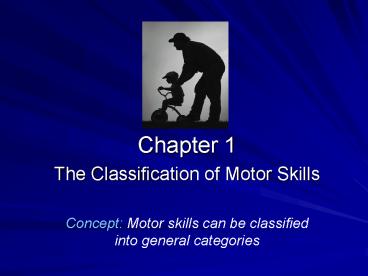The Classification of Motor Skills PowerPoint PPT Presentation
1 / 20
Title: The Classification of Motor Skills
1
.
- Chapter 1
- The Classification of Motor Skills
- Concept Motor skills can be classified into
general categories
2
The Study of Motor Skills Motor Learning,
Control, and Development
- Motor skills require body, head, and/or limb
movement to achieve its goal - Motor learning involves the study of
- Acquisition of new skills
- Performance enhancement of well-learned skills
- Reacquisition of skills following injury,
disease, etc.
3
The study of motor skills(cont.)
- Motor control involves the study of
- How the neuromuscular system functions to enable
coordinated movement - While learning a new skill
- While performing a well-learned skill
- Motor development involves the study of
- Human development from infancy to old age
- Issues related to either motor learning or motor
control
4
University of Delaware Motor-Control Research
Christopher Knight
5
Development of upper limb proprioceptiveaccuracy
in children and adolescentsDaniel J. Goble a,
Colleen A. Lewis a,b,Edward A. Hurvitz b, Susan
H. Brown
6
(No Transcript)
7
Terms Related to Motor Skills Skills, Actions,
and Movement
- Skills - Tasks or activities that have specific
goals to achieve (action goals) - Motor skills vs. cognitive skills
- Actions Term often used as synonymous with
the term motor skills - Movements Behavioral characteristics of a
specific limb or a combination of limbs
8
One-DimensionClassification Systems
- Categorize skills according to one common
characteristic - Divided into two categories, each representing
extreme ends of a continuum
9
One-DimensionClassification Systems, contd
- Three motor skill classifications that use
one-dimension approaches see Figure 1.2 - Size of primary musculature required
- Specificity of where actions begin or end
- Stability of the environment context
10
Size of PrimaryMusculature Required
- The benefit of a continuum approach to skill
classification - Some motor skills involve both types to achieve
the action goal and would be located between the
two points
11
2. Specificity of Where Actions Begin or End
- Two main categories
- Discrete motor skills - specified beginning and
end points, usually require a simple movement - e.g. flipping a light switch
- Continuous motor skills - arbitrary beginning and
end points usually involve repetitive movements - e.g. steering a car
- Combination category Serial motor skills
- Involve a continuous series of discrete skills
- e.g. shifting gears in a stick shift automobile
12
3. Stability of the Environmental Context
- Two main concepts
- Closed motor skills involve a stationary
supporting surface, object, and/or other people
performer determines when to begin the action - e.g. picking up a cup while seated at a table
- Open motor skill involve supporting surface,
object, and/or other people in motion
environment features determines when to begin the
action - e.g. catching a thrown ball
13
A Two-Dimension Classification System
- Gentiles Taxonomy of Motor Skills
- (Table 1.1)
- Taxonomy - A classification system
organized according to relationships among the
component characteristics of what is being
classified
14
Gentiles Two-Dimensions Taxonomy, contd
- Two-dimensions of the taxonomy
- Environmental context
- Function of the action
- 1. Environmental context
- Two characteristics
- Regulatory conditions
- Characteristics of environment that control the
movement characteristics of an action - Intertrial variability
- Whether the regulatory conditions are the same or
different from one performance attempt to another
15
Gentiles Two-Dimensions Taxonomy, contd
- Function of the action
- Two characteristics
- Body orientation
- Does the skill require the person to move from
one location to another or to stay in the same
location - body stability, - maintain same location
- body transport change location (actively or
passively) - Object manipulation
16
(No Transcript)
17
Summary of the 2 Dimensions
- 4 characteristics can describe any motor skill
- 2 Environmental context characteristics
- 1. Are the regulatory conditions stationary or
in motion? - 2. Do the regulatory conditions change from
trial to trial? - 2 Action function characteristics
- 1. Does the action goal require maintaining the
body in the same location or transporting the
body from one place to another? - 2. Is an object manipulated?
18
The 16 Skill Categories
- The interaction of the four environmental context
characteristics and the four action function
characteristics creates 16 skill categories - Table 1.1 shows Gentiles original presentation
of the taxonomy along with two examples of skill
in each category
19
Characteristics of Gentiles Taxonomy
- Each category puts different demands on the
performer - Skill complexity basis for taxonomy organization
- From simplest 1A diagonally to most complex
4D - Complexity increases when a motor skill involves
one or more of the following - Open environment
- Trial-to-trial variability
- Object to manipulate
- Body transport
20
Practical Uses of Gentiles Taxonomy
- Guide for evaluating motor performance
capabilities, limitations, and deficiencies - Systematic basis for selecting progressions of
functionally appropriate activities to - increase performance capabilities
- overcome performance deficiencies
- Chart persons progress developing a profile of
competencies

